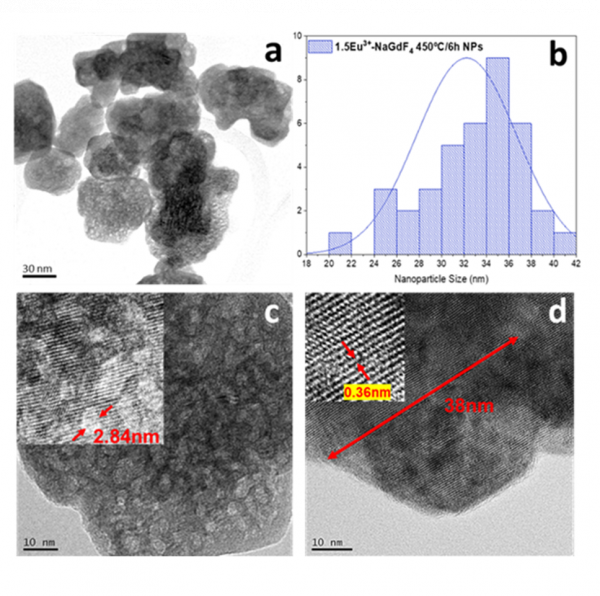Novel Sol-Gel Route to Prepare Eu3+-Doped 80SiO2-20NaGdF4 Oxyfluoride Glass-Ceramic for Photonic Device Applications
In this work, oxyfluoride glass ceramics with molar composition 80SiO2-20(1.5Eu3+: NaGdF4) were prepared by sol-gel following the “pre-crystallized nanoparticles route” with promising optical results. Moreover, Eu3+ ion was selected as dopant due to its excellent properties as local probe, providing important information on the environment structure where it is located.
The development of transparent glass-ceramics (GCs) has drawn the attention of numerous researchers due to their important optical applications in light-emitting diodes, solar cells, sensing or in biomedical materials. Particularly, when fluoride nanocrystals smaller than 40 nm are dispersed in an oxide glass matrix, the resulting materials are transparent GCs, called oxyfluoride glass-ceramics (OxGCs), which have attractive properties. Among fluoride nanocrystals, those with formula ALnF4 (where A is an alkaline element and Ln a lanthanide), have become more attractive in comparison to other fluorides due to their lowest phonon energies and wide band gap (9-10eV). The sol-gel method offers the possibility of obtaining GCs using a cheap, flexible, and melt-free synthesis route with the possibility of processing as bulk, thin film, and powder materials. Sol-gel also allows the final crystal fraction to be controlled by avoiding fluorine loss, which occurs at high temperature during melting quenching, and thus optical efficiency may be improved.
In this collaborative work carried out by the groups led by Alicia Durán (ICV-CSIC) and Rolindes Balda (CFM, UPV/EHU), OxGCs with molar composition 80SiO2-20(1.5Eu3+:NaGdF4) were prepared by sol-gel following the “pre-crystallized nanoparticles route” with promising optical results. The preparation of 1.5 mol % Eu3+-doped NaGdF4 nanoparticles was optimized and characterized by XRD, FTIR and HRTEM (Figure 1). The structural characterization of 80SiO2-20(1.5Eu3+:NaGdF4) OxGCs prepared from these nanoparticles’ suspension revealed the presence of hexagonal and orthorhombic NaGdF4 crystalline phases. The optical properties of both nanoparticles’ phases and the related OxGCs were studied by measuring the emission and excitation spectra together with the lifetimes of the 5D0 state. The emission spectra obtained by exciting the Eu3+-O2- charge transfer band showed similar features in both cases corresponding the higher emission intensity to the 5D0®7F2 transition that indicates a non-centrosymmetric site for Eu3+ ions. Moreover, time resolved fluorescence line-narrowed emission spectra obtained under selective excitation in the 7F0®5D0 transition at 9 K allow to identify two distinguishable sites for Eu3+ ions in the OxGCs powders with C2v and C3 symmetries, which are compatible with the observed hexagonal and orthorhombic phases detected in the XRD diffraction patterns. The results show that this processing method is promising to prepare transparent OxGCs coatings for photonic applications.

Figure 1. HR TEM images of (a) 1.5Eu3+: NaGdF4 NPs heat-treated ay 450 °C for 5 h. (b) The corresponding nanoparticle size distribution taken from the image on “a”, (c) Amplification of the area selected in “a” with the porous size measurement. (d) Amplification of the area selected in “a” with the lattice distance measurement.

Figure 2. Time-resolved fluorescence line-narrowed emission spectra of the 5D0→7F0,1,2 transitions of Eu3+ ions measured at 9 K at a time delay of 10 µs after the laser pulse under an excitation at (a) 578.6 nm and (b) 579 nm, respectively, for the 80SiO2-20(1.5Eu3+: NaGdF4) powders heat-treated at 450 °C for 5 h.



